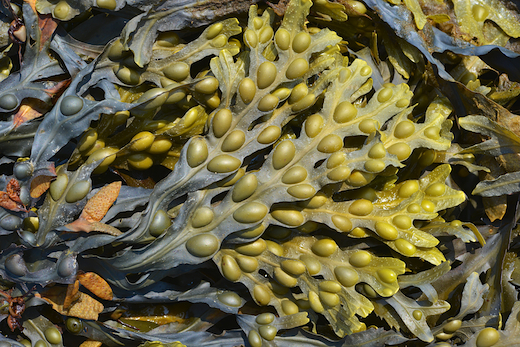Fucus vesiculosus Linnaeus
Fact Sheet (Download PDF)
Common names: Bladder wrack. Feamainn bhoilgíneach (Irish).
Description: Olive-green
to yellow-brown, mid-shore wrack easily recognised by its
paired bladders occurring on either side of a prominent midrib.
The frond is generally not strongly spiralled and the
receptacles do not have a sterile rim (see Fucus spiralis and F. macroguiryi), and the frond does not have a serrated margin (Fucus serratus). Fucus vesiculosus is attached by a small, strongly
attached disc which gives rise to a short stipe. The
reproductive receptacles are swollen area at the tips of fronds
that have many flask-shaped cavities called conceptacle, which house the male and female reproductive structures known as
antheridia (borne on antheridiophores) and stalked oogonia (containing 8
eggs), respectively. The eggs and sperm are liberated onto the
surface of the receptacles and a pheromone (sex-attracting
substance) is released by the eggs that attracts the sperm.
Fertilization results in a zygote that forms a new Fucus adult. Should not be confused with Ascophyllum nodosum, which has bladders singly on the frond. This is the most morphologically diverse of the fucoid species, with individualvarying greatly in size and shape. For example, plants can reach up to 1 m on sheltered shores with many pairs of bladders while at the other extreme on exposed shores, plants rarely exceed 20 cm and may have no bladders.
Distribution: This species is very common in the North
Atlantic south to the Canary Islands and North Carolina. Records from other areas require confirmation. A bladderless form occurs
on more wave-exposed shores in the NE Atlantic (last picture
below).
Usage: Fucus vesiculosus is widely used in cosmetic
preparations and in thalassotherapy.



-
 BioAtlantis
provides sustainable technologies from the sea to enhance
plant, animal and human health.
BioAtlantis
provides sustainable technologies from the sea to enhance
plant, animal and human health.
-
 Connemara Organic Seaweed Company
provide hand harvested, sustainable, kelp and seaweed products
for human consumption through health supplements and edible
products.
Connemara Organic Seaweed Company
provide hand harvested, sustainable, kelp and seaweed products
for human consumption through health supplements and edible
products.
-
 Emerald Isle Organic Irish Seaweed.
A family business producing seaweed as supplements,
cooking, gardening and bath products.
Emerald Isle Organic Irish Seaweed.
A family business producing seaweed as supplements,
cooking, gardening and bath products.
-
 Irish Seaweeds Ltd
are suppliers of 100% natural hand-harvested seaweeds and
edible sea vegetable products from Ireland.
Irish Seaweeds Ltd
are suppliers of 100% natural hand-harvested seaweeds and
edible sea vegetable products from Ireland.
